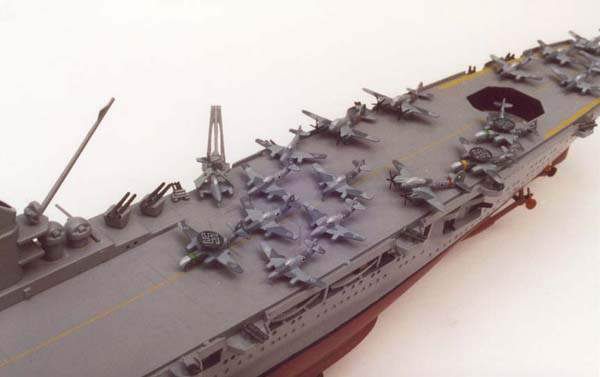


Brief HistoryDuring the first voyages of the Graf Zeppelin in 1941
it became obvious that the Me-109 was not an ideal aircraft to operate
from a carrier. This was mainly due to its narrow track undercarriage
and short range. For the long term the navy wanted the new Me-262 and Ar-234 jets for its carriers, the Graf Zeppelin and her sister ships the Adolf Hitler and the Kaizer Wilhelm. The problem with the early jets was that they needed a relatively long take-off run because of the slow revving engines. Also range was a problem. In 1945 is was decided to put the Graf Zeppelin in dry-dock for an extensive refit. Its anti-aircraft armament was updated and a new radar installed. To make it possible to operate jets from her deck this was lengthened by 15 meters and the catapults were replaced. The new system didn't use the launching cradles used by the old catapults but instead used a system whereby the catapult was attached to the nose gear of the aircraft. Messerschmitt and Arado developed special versions of
the Me-262 and Ar-234. The Messerschmitt Me-262T-1 was developed in 1945
from the Me-262F fighter using more powerful Jumo 004K engines. The
airframe was strengthened for carrier use and equipped with wings that
folded just outboard of the engines. The Jumo 004K engine had a Walter
rocket unit integrated in the engine for extra take-off power. The Me-262T's performed very well against the US and Canadian prop fighters like the Hellcat and Bearcat. Only the introduction of the North American FJ Fury jet fighter enabled the allies to counter the Me-262 on equal terms. The Arado Ar-234T-1 was a very advanced aircraft for its time. It featured a revolving radar antenna on top of the aircraft and could function as an early warning aircraft flying high above the fleet. The system was first tested in 1945 and 3 Ar-234T's were stationed on the Graf Zeppelin when it sailed in November 1946. This system proved decisive in the sea battles against the remains of the British fleet which had fled from the UK to Canada when England fell to the Germans in december 1940. Because of the early warning system several Canadian air strikes could be thwarted. As a torpedo bomber the Graf Zeppelin carried a number of converted Me-410 aircraft. These were standard production Me-410B's converted to Me-410G-1 status, featuring a stronger DB603S engine and a strengthened undercarriage. These aircraft were quite satisfactory, in fact they were used as carrier bombers until 1963. The two sister ships of the Graf Zeppelin were converted to her standard in 1947 and 1948. The Graf Zeppelin remained in active service until the 6th of September 1957 when she was sold to Argentine and was renamed Rio Major. |
The modelThe model is the Revell Graf Zeppelin kit with an altered flight deck. I made the conversion to 1946 standard because I was very disappointed with the aircraft Revell supplies with the kit. The term "blobs" best describes them. The aircraft on the 1946 GZ are all from White Ensign models in the UK who make a large range of excellent resin aircraft in 1/700.
|
Last updated: 14/03/2009